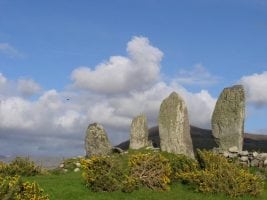- Created: June 12, 2013 10:39 pm
- Updated: December 12, 2017 10:59 am
- Distance Instructions
- Distance 0 m
- Time 0 s
- Speed 0.0 km/h
- Min altitude 0 m
- Peak 0 m
- Climb 0 m
- Descent 0 m
The Eightercua Stone Row is a Megalithic tomb comprising a row of four stones aligned in an east-west direction, they are located 1.5 km south of Waterville, County Kerry in the south west of Ireland. The tallest stone reaches 2.7m (9 feet) in height, and the alignment stretches for twenty five feet in an east-west direction. Around the row are the possible remains of a tomb and ancient enclosure, suggesting that the site had a ritual purpose at one time. Eightercua is thought to originate from around 1700 BC, and in Irish Mythology is said to be the burial place of Scéine, wife of a Bard and Judge of the Milesian invaders, Amergin mac Míled. She died as the Milesians invaded Ireland. The Milesians, said to be the last of the mythical invaders to Ireland, settled the area around in 1700 BC and reportedly left behind many of the archaeological sites found in the area.
The Eightercua Stone Row is a Megalithic tomb comprising a row of four stones aligned in an east-west direction, they are located 1.5 km south of Waterville, County Kerry in the south west of Ireland. The tallest stone reaches 2.7m (9 feet) in height, and the alignment stretches for twenty five feet in an east-west direction. Around the row are the possible remains of a tomb and ancient enclosure, suggesting that the site had a ritual purpose at one time. Eightercua is thought to originate from around 1700 BC, and in Irish Mythology is said to be the burial place of Scéine, wife of a Bard and Judge of the Milesian invaders, Amergin mac Míled. She died as the Milesians invaded Ireland. The Milesians, said to be the last of the mythical invaders to Ireland, settled the area around in 1700 BC and reportedly left behind many of the archaeological sites found in the area.


